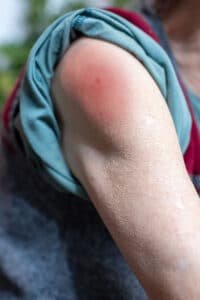By Eva Briggs, MD
 Recently a physician assistant colleague called me to ask whether I had any ideas about what was going on with his patient.
Recently a physician assistant colleague called me to ask whether I had any ideas about what was going on with his patient.
After receiving a dose of the Moderna COVID-19 vaccine, the patient developed had a hard red painful lump at the injection site.
At the time I didn’t have a name for this finding. I suspected it was a reaction to the vaccine that would go away on its own in a few days.
I experienced the exact same phenomenon after my second Moderna vaccine.
My arm developed a hard red lump measuring 3 inches in diameter. It was moderately painful and tender, as well as a little itchy. It started the day after the vaccine and gradually subsided over one week.
It turns out that there is a name for this — COVID arm.
Scientists are not sure of the underlying mechanism. Although annoying, it appears to be harmless. It certainly beats getting COVID-19. For some people the reaction starts as long as one week after the vaccine. There can even be several red blotches on the arm where the vaccine was administered. It’s more common with the second dose. It does not seem to occur with the Pfizer vaccine.
The articles I read stated it is rare. But that’s probably because patients and doctors fail to report it. After all, many other common vaccines, such as tetanus toxoid, also cause redness and swelling. More women than men experience COVID arm.
Over-the-counter pain relievers will treat the pain. For itching, use an antihistamine by mouth such as diphenhydramine, or hydrocortisone cream, or ice packs. It is not an infection and does not require antibiotics. Other side effects which may occur with either vaccine include muscle aches, chills, tiredness, and headache. But these resolve in one or two days.
Don’t let the minor inconvenience of side effects discourage you from receiving the vaccine and when you are eligible.
Here are few myths about the COVID-19 vaccine.
• Myth 1: COVID-19 vaccine causes infertility in women.
The COVID-19 vaccine teaches the body to recognize and fight a spike protein on the surface of the virus. Because a spike protein is involved in the attachment and growth of the placenta, some people thought that the COVID vaccine would inhibit this spike protein. But the two spike proteins are completely different, and the vaccine does not cross-react.
• Myth 2: People who have already had COVID-19 disease don’t need a vaccine.
Because we don’t know how long immunity from natural infection lasts, and the disease is potentially deadly, scientists recommend the vaccine even for people who have had the illness. The vaccine has not caused problems for people who previously had COVID-19.
• Myth 3: Now that COVID-19 vaccines have been developed, vaccines to prevent the common cold and HIV will soon be available.
Alas, these other viruses are completely different and distinct and vaccines to prevent them are not right around the corner.
• Myth 4: As soon someone receives the COVID-19 vaccine, he or she can quit the mask and social distancing.
It’s too soon to stop these public health measures. The vaccine prevents severe disease, but we don’t know yet whether the vaccine prevents people from carrying the virus without symptoms and spreading it to others.
Eva Briggs is a retired medical doctor who practiced in Central New York for several decades. She lives in Marcellus.

